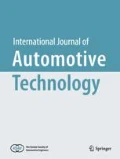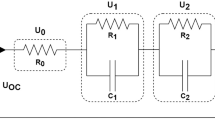Abstract
Accurate estimation of battery State of Charge (SOC) is a crucial factor for the safe and efficient usage of the batteries in hybrid electric vehicles. The combined method of Coulomb counting and Open circuit Voltage (OCV) is already under practical usage for the estimation of battery SOC, but the methods have significant error when there is parasitic current leakage (dark current) or short rest period. Thus, Extended Kalman Filter (EKF) is one of the battery SOC estimation methods used to overcome such drawbacks. And, most importantly, due to structural dependency of EKF upon battery model, the battery model used for the EKF contributes significantly to the accuracy of EKF. Thus, in this paper, 3 types of battery Equivalent Circuit Models (ECMs) including second order RC model, first order RC model, and R model are compared under practical vehicle driving conditions. To simulate the vehicle driving condition, a micro Hybrid Electric Vehicle (micro-HEV) is modeled and simulation is conducted under NEDC condition.
Similar content being viewed by others
Abbreviations
- C :
-
charge, As
- dt :
-
time step, s
- f(x) :
-
state function of dynamic system
- h(x) :
-
predicted measurement function of dynamic system
- H:
-
∂h/∂x
- I :
-
current, A
- K :
-
kalman gain
- OCV :
-
open circuit voltage, V
- P(+) :
-
a priori covariance of state error
- P(-) :
-
a posteriori covariance of state error
- Q :
-
covariance of process noise
- R :
-
covariance of measurement noise
- R i :
-
internal resistance, ohm
- SOC :
-
State of Charge, %
- V :
-
voltage, V
- V :
-
measurement noise, V
- w :
-
process noise
- x :
-
a priori state
- \({\bf{\hat x}}\) :
-
a posteriori state
- z :
-
a priori measurement, V
- ẑ:
-
a posteriori measurement, V
- Φ:
-
∂f/∂x
- k:
-
iteration
- 1:
-
first RC region
- 2:
-
second RC region
- AGM:
-
absorbent glass mat
- BMS:
-
battery management system
- DC:
-
direct current
- EIS:
-
electrochemical impedance spectroscopy
- EKF:
-
extended kalman filter
- EMS:
-
energy management strategy
- HEV:
-
hybrid electric vehicle
- HILS:
-
hardware-in-the-loop simulation
- HPPC:
-
hybrid pulse power characterization
- ICE:
-
internal combustion engine
- ISS:
-
idle start stop
- KF:
-
Kalman filter
- NEDC:
-
new European driving cycle
- OCV:
-
open circuit voltage
- PF:
-
particle filter
- SOC:
-
state of charge
- SOH:
-
state of health
- SPKF:
-
sigma point Kalman filter
- UKF:
-
unscented Kalman filter
References
Affanni, A., Bellini, A., Concari, C., Franceschini, G., Lorenzani, E. and Tassoni, C. (2003). EV battery state of charge: neural network based estimation. IEEE Int. Electric Machines and Drives Conf. Madison, WI, USA.
Belt, J. R (2015). Battery Test Manual For 12 Volt Start/Stop Hybrid Electric Vehicles. Idaho National Laboratory, Idaho Falls, Idaho 83415. INL/EXT-12-26503, Revision 1.
Butler, K. L., Ehsani, M. and Kamath, P. (1999). A Matlab-based modeling and simulation package for electric and hybrid electric vehicle design. IEEE Trans. Vehicular Technology 48,6, 1770–1778.
Coleman, M., Lee, C. K., Zhu, C. and Hurley, W. G. (2007). State-of-charge determination from EMF voltage estimation: Using impedance, terminal voltage, and current for lead-acid and lithium-ion batteries. IEEE Trans. Industrial Electronics 54, 5, 2550–2557.
Farag, M., Fleckenstein, M. and Habibi, S. R. (2014). Li-ion battery SOC estimation using non-linear estimation strategies based on equivalent circuit models. SAE Technical Paper No. 2014-01-1849.
Gao, M., Liu, Y. And He, Z. (2011). Battery state of charge online estimation based on particle filter. Int. Cong. Image and Signal processing, IEEE, 4, 2233–2236.
Jo, H. (2017). Case based diagnosis modeling of dark current causes and standardization of diagnosis process, Trans. Korean Society of Automotive Engineers 25,2, 149–156.
Karden, E., Ploumen, S., Fricke, B., Miller, T. and Snyder, K. (2007). Energy storage devices for future hybrid electric vehicles. J. Power Sources 168, 1, 2–11.
Kim, S. C. and Hong, W. H. (1999). Analysis of the discharge performance of a flooded lead/acid cell using mathematical modelling. J. Power Sources 77,1, 74–82.
Lee, J., Nam, O. and Cho, B. H. (2007). Li-ion battery SOC estimation method based on the reduced order extended Kalman filtering. J. Power Sources 174, 1, 9–15.
Lee, S., Cherry, J., Safoutin, M. and McDonald, J. (2017). Modeling and validation of 12V lead-acid battery for stop- start technology. SAE Technical Paper No. 2017-01-1211.
Li, S. and Ke, B. (2011). Study of battery modeling using mathematical and circuit oriented approaches. IEEE Power and Energy Society General Meeting. Detroit, MI, USA.
Mariani, A., Thanapalan, K., Stevenson, P., Stockley, T. and Williams, J. (2015). Techniques for monitoring and predicting the OCV for VRLA battery systems 2015 21st Int. Conf. Automation and Computing (ICAC). Glasgow, Scotland, UK.
Moo, C. S., Ng, K. S., Chen, Y. P. and Hsieh, Y. C. (2007). State-of-charge estimation with open-circuit-voltage for lead-acid batteries. Power Conversion Conf. Nagoya IEEE. Nagoya, Aichi, Japan.
Ng, K S., Moo, C. S., Chen, Y. P. and Hsieh, Y. C. (2008). State-of-charge estimation for lead-acid batteries based on dynamic open-circuit voltage. IEEE 2nd Int. Power and Energy Conf. Johor Bahra, Johor, Malaysia.
Pascoe, P. E. and Anbuky, A. H. (2004). A VRLA battery simulation model. Energy Conversion and Management 45, 7–8, 1015–1041.
Piller, S., Perrin, M. and Jossen, A. (2001). Methods for state-of-charge determination and their applications. J. Power Sources 96, 1, 113–120.
Plett, G. L. (2004). Extended Kalman filtering for battery management systems of LiPB-based HEV battery packs: Part 3. State and parameter estimation. J. Power Sources 134, 2, 277–292.
Plett, G. L. (2006). Sigma-point Kalman filtering for battery management systems of LiPB-based HEV battery packs: Part 1: Introduction and state estimation. J. Power Sources 161, 2, 1356–1368.
Sakurai, K., Kanekawa, N., Tsunedomi, K., Sasaki, S., Oyama, K., Yokoyama, T. and Watabe, M. (2004). High performance and cost-effective electronic controller architecture for powertrain systems. SAE Technical Paper No. 2004-01-0209.
Salkind, A. J., Fennie, C., Singh, P., Atwater, T. and Reisner, D. E. (1999). Determination of state-of-charge and state-of-health of batteries by fuzzy logic methodology. J. Power Sources 80, 1–2, 293–300.
Sepasi, S., Ghorbani, R. And Liaw, B. Y. (2014). A novel on-board state-of-charge estimation method for aged Li-ion batteries based on model adaptive extended Kalman filter. J. Power Sources, 245, 337–344.
Tian, Y., Xia, B., Sun, W., Xu, Z. and Zheng, W. (2014). A modified model based state of charge estimation of power lithium-ion batteries using unscented Kalman filter. J. Power Sources, 270, 619–626.
Truchot, C., Dubarry, M. And Liaw, B. Y. (2014). State-of-charge estimation and uncertainly for lithium-ion battery strings. Applied Energy, 119, 218–227.
Unger, J., Hametner, C., Jakubek, S. and Quasthoff, M. (2014). A novel methodology for non-linear system identification of battery cells used in non-road hybrid electric vehicles. J. Power Sources 269, 883–897.
Yatsui, M. W. and Bai, H. (2011). Kalman filter based state-of-charge estimation for lithium-ion batteries in hybrid electric vehicles using pulse charging. 2011 IEEE Vehicle Power and Propulsion Conf. (VPPC). Chicago, IL, USA.
Yun, S., Park, S., Kim, D., Lee, J., Kim, S. and Kim, K. Y. (2015). Design optimization of alternator and battery systems with a recuperation control algorithm for a midsized sedan. SAE Technical Paper No. 2015-01-1188.
Zhang, Y., Song, W., Lin, S. and Feng, Z. (2014). A novel model of the initial state of charge estimation for LiFePO4 batteries. J. Power Sources, 248, 1028–1033.
Acknowledgement
This work was supported by the Korea Institute of Energy Technology Evaluation and Planning (KETEP) grant funded by the Korea government (MOTIE) (NO.R0006240, “Development about Li-Ion Dual Battery Based High Efficiency Lead-Acid Battery for Micro-hybrid Vehicle”) and “3rd Generation xEV industry development project for market independence” funded by the Korea government (MOTIE) (No. 20011629)
Author information
Authors and Affiliations
Corresponding author
Additional information
Publisher’s Note
Springer Nature remains neutral with regard to jurisdictional claims in published maps and institutional affiliations.
Rights and permissions
About this article
Cite this article
Oh, H., Jeon, J. & Park, S. Effects of Battery Model on the Accuracy of Battery SOC Estimation Using Extended Kalman Filter under Practical Vehicle Conditions Including Parasitic Current Leakage and Diffusion Of Voltage. Int.J Automot. Technol. 22, 1337–1346 (2021). https://doi.org/10.1007/s12239-021-0116-1
Received:
Revised:
Accepted:
Published:
Issue Date:
DOI: https://doi.org/10.1007/s12239-021-0116-1




